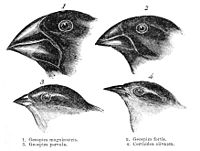
Photo from wikipedia
Due to their integral roles in oxidative phosphorylation, mitochondrially encoded proteins represent common targets of selection in response to altitudinal hypoxia across high-altitude taxa. While previous studies revealed evidence of… Click to show full abstract
Due to their integral roles in oxidative phosphorylation, mitochondrially encoded proteins represent common targets of selection in response to altitudinal hypoxia across high-altitude taxa. While previous studies revealed evidence of positive selection on mitochondrial genomes of high-altitude Phrynocephalus lizards, their conclusions were restricted by out-of-date phylogenies and limited taxonomic sampling. Using topologies derived from both nuclear and mitochondrial DNA phylogenies, we re-assessed the evidence of positive selection on the mitochondrial genomes of high-altitude Phrynocephalus . We sampled representative species from all four main lineages and sequenced the mitochondrial genome of P. maculatus , a putative sister taxon to the high-altitude group. Positive selection was assessed through two widely used branch-site tests: the branch-site model in PAML and BUSTED in HyPhy. No evidence of positive selection on mitochondrial genes was detected on branches leading to two most recent common ancestors of high-altitude species; however, we recovered evidence of positive selection on COX1 on the P. forsythii branch, which represents a reversal from high- to low-elevation environments. A positively selected site therein marked a threonine to valine substitution at position 419. We suggest this bout of selection occurred as the ancestors of P. forsythii re-colonized lower altitude environments north of the Tibetan Plateau. Despite their role in oxidative phosphorylation, we posit that mitochondrial genes are unlikely to have represented historical targets of selection for high-altitude adaptation in Phrynocephalus . Consequently, future studies should address the roles of nuclear genes and differential gene expression.
Journal Title: Journal of Molecular Evolution
Year Published: 2021
Link to full text (if available)
Share on Social Media: Sign Up to like & get
recommendations!